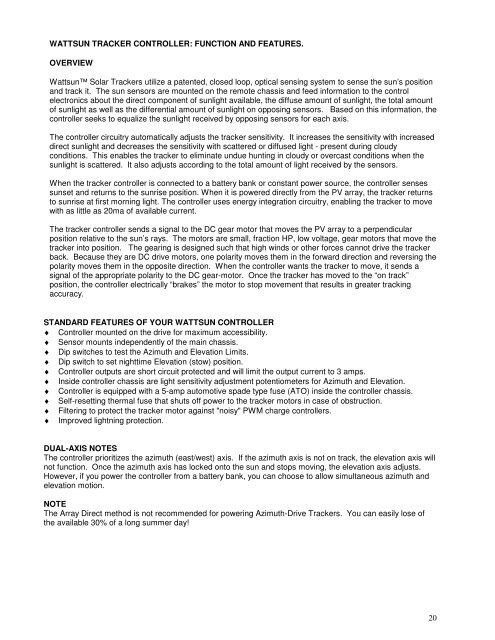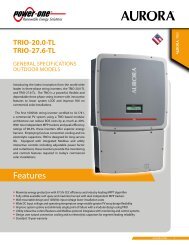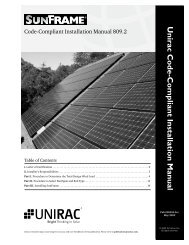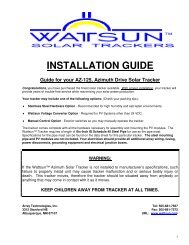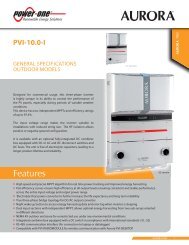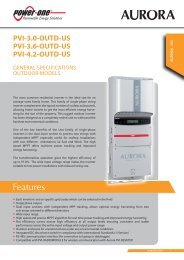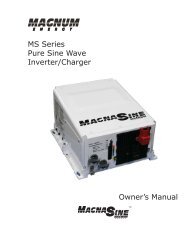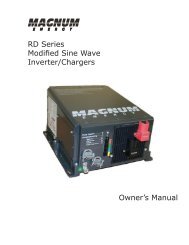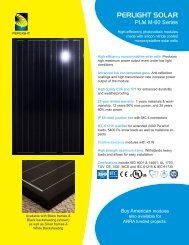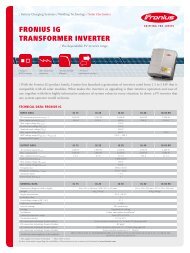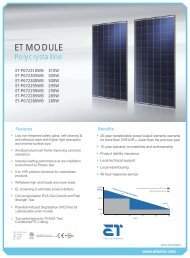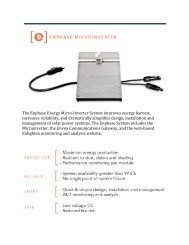AZ-225 Install Manual
AZ-225 Install Manual
AZ-225 Install Manual
You also want an ePaper? Increase the reach of your titles
YUMPU automatically turns print PDFs into web optimized ePapers that Google loves.
WATTSUN TRACKER CONTROLLER: FUNCTION AND FEATURES.<br />
OVERVIEW<br />
Wattsun Solar Trackers utilize a patented, closed loop, optical sensing system to sense the sun’s position<br />
and track it. The sun sensors are mounted on the remote chassis and feed information to the control<br />
electronics about the direct component of sunlight available, the diffuse amount of sunlight, the total amount<br />
of sunlight as well as the differential amount of sunlight on opposing sensors. Based on this information, the<br />
controller seeks to equalize the sunlight received by opposing sensors for each axis.<br />
The controller circuitry automatically adjusts the tracker sensitivity. It increases the sensitivity with increased<br />
direct sunlight and decreases the sensitivity with scattered or diffused light - present during cloudy<br />
conditions. This enables the tracker to eliminate undue hunting in cloudy or overcast conditions when the<br />
sunlight is scattered. It also adjusts according to the total amount of light received by the sensors.<br />
When the tracker controller is connected to a battery bank or constant power source, the controller senses<br />
sunset and returns to the sunrise position. When it is powered directly from the PV array, the tracker returns<br />
to sunrise at first morning light. The controller uses energy integration circuitry, enabling the tracker to move<br />
with as little as 20ma of available current.<br />
The tracker controller sends a signal to the DC gear motor that moves the PV array to a perpendicular<br />
position relative to the sun’s rays. The motors are small, fraction HP, low voltage, gear motors that move the<br />
tracker into position. The gearing is designed such that high winds or other forces cannot drive the tracker<br />
back. Because they are DC drive motors, one polarity moves them in the forward direction and reversing the<br />
polarity moves them in the opposite direction. When the controller wants the tracker to move, it sends a<br />
signal of the appropriate polarity to the DC gear-motor. Once the tracker has moved to the “on track”<br />
position, the controller electrically “brakes” the motor to stop movement that results in greater tracking<br />
accuracy.<br />
STANDARD FEATURES OF YOUR WATTSUN CONTROLLER<br />
♦ Controller mounted on the drive for maximum accessibility.<br />
♦ Sensor mounts independently of the main chassis.<br />
♦ Dip switches to test the Azimuth and Elevation Limits.<br />
♦ Dip switch to set nighttime Elevation (stow) position.<br />
♦ Controller outputs are short circuit protected and will limit the output current to 3 amps.<br />
♦ Inside controller chassis are light sensitivity adjustment potentiometers for Azimuth and Elevation.<br />
♦ Controller is equipped with a 5-amp automotive spade type fuse (ATO) inside the controller chassis.<br />
♦ Self-resetting thermal fuse that shuts off power to the tracker motors in case of obstruction.<br />
♦ Filtering to protect the tracker motor against "noisy" PWM charge controllers.<br />
♦ Improved lightning protection.<br />
DUAL-AXIS NOTES<br />
The controller prioritizes the azimuth (east/west) axis. If the azimuth axis is not on track, the elevation axis will<br />
not function. Once the azimuth axis has locked onto the sun and stops moving, the elevation axis adjusts.<br />
However, if you power the controller from a battery bank, you can choose to allow simultaneous azimuth and<br />
elevation motion.<br />
NOTE<br />
The Array Direct method is not recommended for powering Azimuth-Drive Trackers. You can easily lose of<br />
the available 30% of a long summer day!<br />
20


